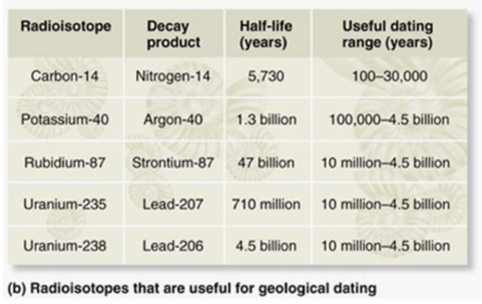Multiple Choice
The age of a fossil can be estimated by analyzing the decay of radioisotopes within the accompanying rock. If you suspected a fossil was 100 million years old, which type of radioisotopes would you use to analyze the accompanying rock?

A) Potassium-40/Argon-40 (half-life = 1.3 billion years; useful dating range =100,000-4.5 billion years)
B) Rubidium-87/Strontium-87 (half-life = 47 billion years; useful dating range = 10 million-4.5 billion years)
C) Uranium-235/Lead-207 (half-life = 710 million years; useful dating range = 10 million-4.5 billion years)
D) Carbon-14/Nitrogen-14 (half-life = 5,730 years; useful dating range = 100-50,000 years)
E) Uranium-238/Lead-238 (half-life 4.5 billion years; useful dating range = 10 million-4.5 billion years)
Correct Answer:

Verified
Correct Answer:
Verified
Q2: You have just invented a time machine
Q3: When lipids, phosphates, carbohydrates and RNA were
Q4: Which of the following are thought to
Q5: Because hardly any oxygen (O<sub>2</sub>) was in
Q6: A protobiont<br>A) has a boundary, or membrane.<br>B)
Q7: John Bernal suggested that prebiotic synthesis of
Q8: To explain the origin of the nuclear
Q9: Which of the following would likely fossilize
Q10: The origin of the mitochondrion and chloroplast
Q11: In eukaryotes, genes involved in transcription and